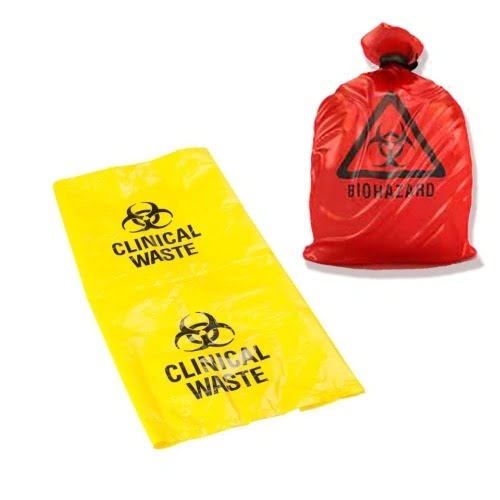Biohazard disposal bags are essential tools in waste management, specifically designed to contain and dispose of biohazardous materials safely. These bags are often seen in medical facilities, laboratories, and places where hazardous waste is produced. Their primary purpose is to provide a secure way to handle and dispose of materials that could pose health risks to humans, animals, and the environment.
Table of Contents
What is a biohazard disposal bag?
A biohazard waste bag, also known as a biohazard waste bag or biomedical waste bag, is a specially designed bag used to safely dispose of materials contaminated with potentially infectious substances or biological hazards. These bags typically consist of heavy plastic and feature color-coding to distinguish them from regular trash bags.
A biohazard waste bag aims to prevent the spread of pathogens or toxins that could pose a risk to human health or the environment. They are commonly used in healthcare facilities, laboratories, research institutions, and other settings where biohazard waste needs to be safely handled and disposed of.

What materials are used for biohazard waste bags?
Biohazard waste bags typically consist of solid and durable materials designed to withstand the potential hazards of biohazard waste. The most common materials used for biohazard waste bags include:
High-density polyethylene (HDPE)
HDPE is a strong, flexible plastic that is resistant to punctures, tears, and leaks. Its durability and ability to contain potentially hazardous materials make it a common choice for biohazard waste bags.
Low-density polyethylene (LDPE)
Another plastic commonly used for biohazard waste bags is LDPE. Its flexibility and chemical resistance make it suitable for containing biohazard waste.
Polypropylene (PP)
PP is a thermoplastic polymer commonly used for biohazard bags. It is known for its strength, durability, and resistance to chemicals and punctures.
Polyvinyl chloride (PVC)
PVC, a synthetic plastic material, commonly serves as the primary material for biohazard bags. It offers strength, flexibility, and resists chemicals and punctures.
What items are stored in biohazard waste bags?
Biohazard waste bags are designed to store and dispose of biohazardous or infectious materials safely. Some everyday items stored in biohazard waste bags include:
- Used gloves and masks
- Contaminated personal protective equipment (PPE)
- Used needles, syringes and lancets
- DIRTY VENTS AND ASSERTIONS
- Blood-soaked materials
- Laboratory cultures and specimens
- Pathological waste (e.g. tissues, organs, body parts)
- Microbiological waste (e.g. cultures, Petri dishes)
- Contaminated hole containers
- Broken glassware contaminated with biohazardous substances
- Animal waste or carcasses contaminated with infectious materials
- Any other item or material that has come into contact with potentially infectious agents or biohazardous substances.
How should bio-waste bags be handled?
Handle medical waste bags carefully to prevent the spread of potentially infectious materials. Here are some guidelines for handling biological waste bags:
1. Personal protective equipment (PPE): Before handling biohazard waste bags, wear appropriate PPE such as gloves, goggles, and a lab coat or disposable gown. This helps protect you from potential exposure to pathogens.
2. Segregation: To prevent contamination, keep biohazard waste bags separate from other waste streams. Collect biohazard waste in designated bins or containers.
3. Proper labelling: Ensure that the biohazard waste bags clearly display the international biohazard symbol and the words “biohazard” or “infectious waste.” This will alert others to potential hazards and help prevent accidental exposure.
4. Secure closure: Seal the biohazard waste bags tightly to prevent leakage or accidental opening. Use zip ties, twist ties or tape to secure the bag opening.
5. Avoid overloading: Do not overload biohazard bags. Leave enough space at the top for proper closure and handling without risking spills or tears.
6. Safe transportation: When transporting biohazard waste bags, use appropriate leak-proof and easy-to-clean carts or containers. Avoid dragging or dropping the bags to prevent damage or breakage.
7. Disposal: Follow local regulations and guidelines for properly disposing of biological waste bags. You must typically incinerate or autoclave these bags to ensure they destroy infectious materials.
8. Decontamination: Hand wash your hands thoroughly with soap and water after handling biohazard bags. If contamination occurs, clean the affected area with an appropriate disinfectant.
Where to buy biohazard waste bags?
Medical Siny manufacturers and suppliers wholesale medical waste bags. In addition, we provide customizable services. Medical Siny can meet your needs. If you need medical consumable, manufacturers and suppliers
Safe Handling of Biohazard Disposal Bags
Proper handling is just as important as the use of biohazard disposal bags themselves. Here are a few critical practices for safely handling these bags:
- Wear Personal Protective Equipment (PPE): Anyone handling biohazard bags should wear appropriate PPE, such as gloves, gowns, and face protection, to prevent direct contact with potentially infectious materials.
- Seal bags properly: Ensure you tightly seal biohazard bags before moving or disposing of them. This reduces the risk of spillage or contamination.
- Labeling: Label each biohazard bag clearly with the appropriate biohazard symbol and a description of the waste inside. This helps waste management workers handle the material appropriately.
- Transporting Waste: Transport biohazardous waste in leak-proof, puncture-resistant containers to prevent accidents during handling or transportation to disposal facilities
Conclusion
A biohazard disposal bag, also called a biohazard waste collection bag or red bag, safely collects and disposes of biohazardous waste.
In summary, biohazard disposal bags are essential tools in healthcare settings for managing potentially harmful waste safely and effectively, protecting public health and the environment.
FAQs
What items should go in a biohazard disposal bag?
Place any materials contaminated with human body fluids, pathogens, or biological waste in a biohazard disposal bag. This includes used syringes, bandages, gloves, and lab samples.
Are biohazard disposal bags environmentally friendly?
Manufacturers make some biohazard bags with biodegradable materials, but the waste inside still needs treatment through incineration or sterilization to ensure safety.
Where can I buy biohazard disposal bags?
You can purchase biohazard disposal bags from medical supply stores, laboratory suppliers, or online. It’s essential to ensure the bags meet regulatory standards for your region.
Do all healthcare facilities use biohazard disposal bags?
All healthcare facilities must use biohazard disposal bags to dispose of infectious or hazardous medical waste safely.



























































